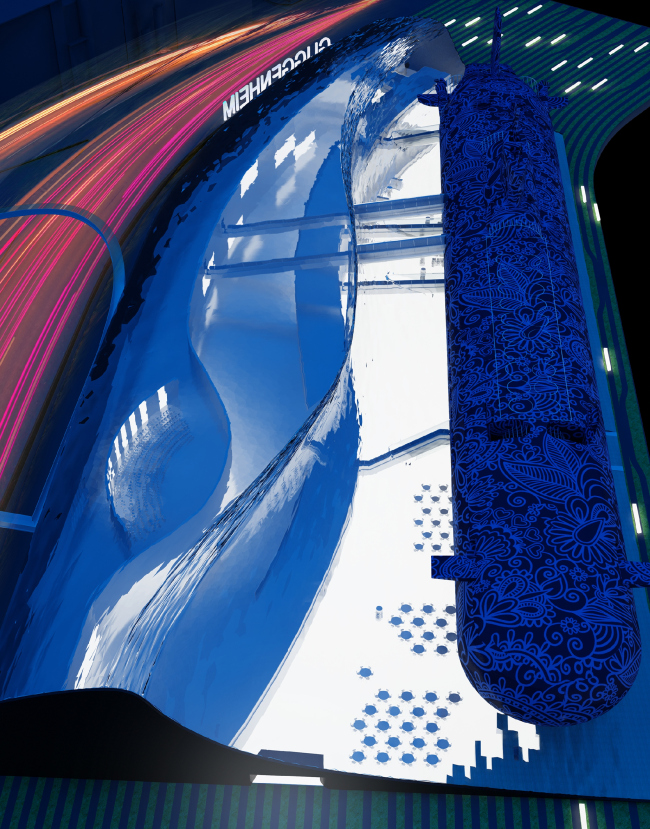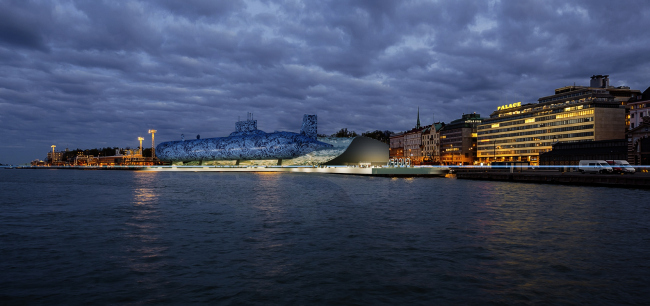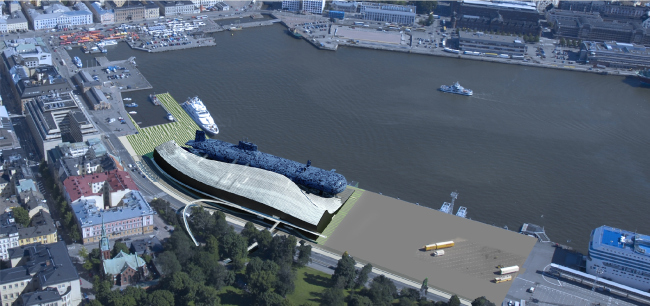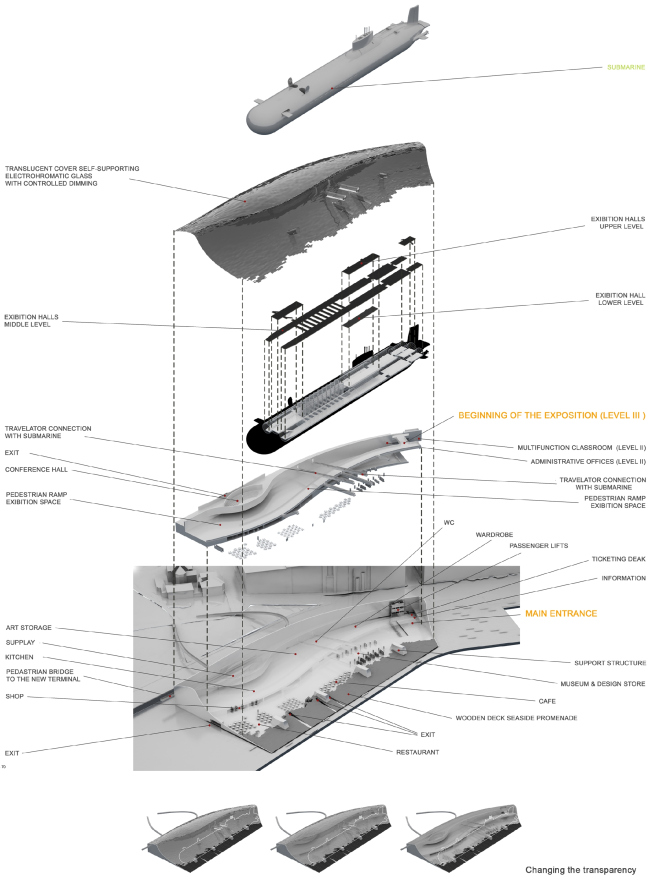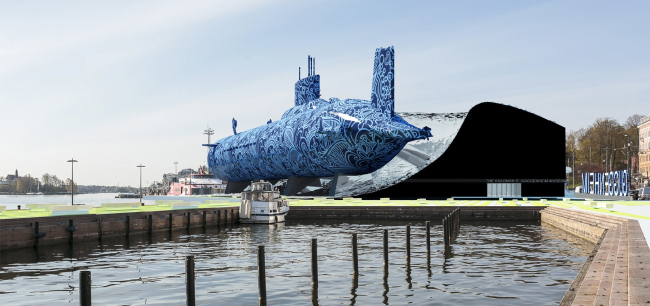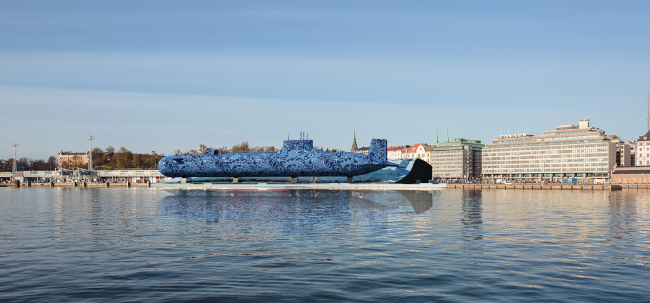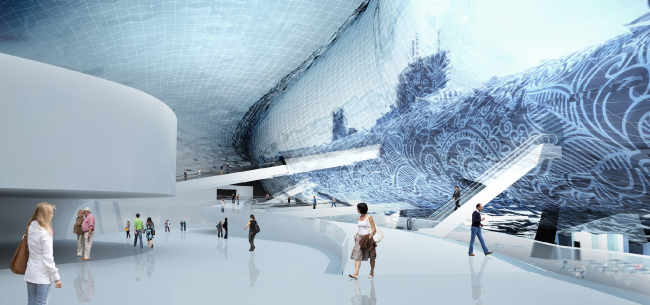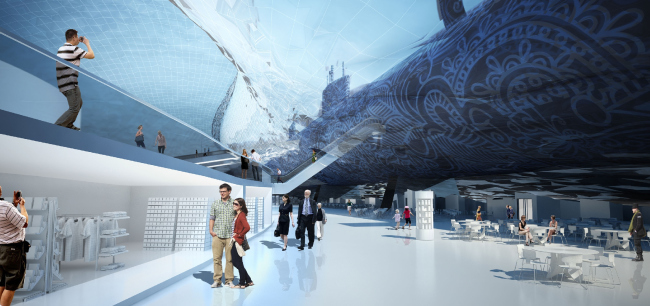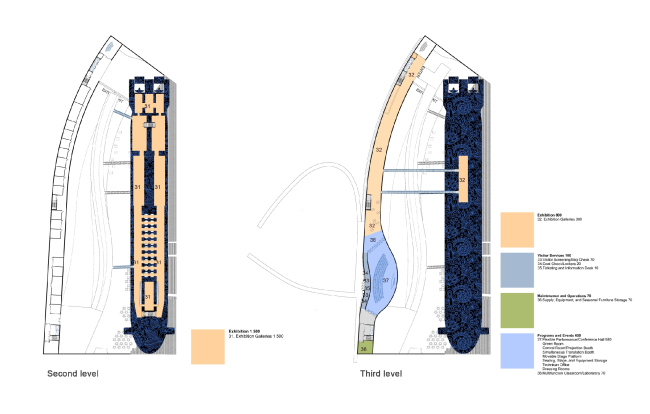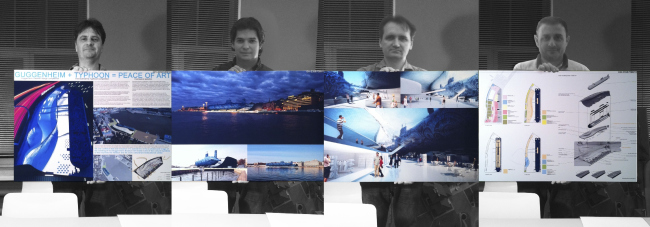|
Published on Archi.ru (https://archi.ru) |
|
| 28.01.2015 | |
|
Russian Submarine as Guggenheim Museum in Helsinki |
|
|
Alla Pavlikova |
|
| Studio: | |
| 4izmerenie | |
|
The architectural bureau "Fourth Dimension" proposed to create Guggenheim Museum in Helsinki inside a Russian submarine. Guggenheim Museum in Helsinki. Contest project © "Fourth Dimension"The submarine-based project of the museum was developed by "Fourth Dimension" for two architectural contests at once. The first one was announced by Solomon Guggenheim Foundation and required the architects from around the globe to come up with an image of the new museum that the foundation was going to build in Helsinki as a new and easily identified symbol of this city. The second one came quite unexpected and was not really architectural - organized by “matterbetter” team, it was a contest named “The Submarine” that was aimed at revising the purpose and the meaning of the dangerous weapon - Russian submarine of "Typhoon" class, one of the biggest in the world. In 2013, by the decision of the government of the Russian Federation, two such submarines were written off the inventory due to their high maintenance costs and their obsolete equipment. One of such submarines was to be transformed into a peaceful object. The two contests took place almost at the same time, and the architects of Moscow's "Fourth Dimension" decided to roll the two tasks into one proposing to turn Helsinki's Guggenheim Museum into a giant art-object in the form of a submarine. The contest of Solomon Guggenheim Foundation became, probably, one of the most high-profile and popular events in the world of architecture over the last year attracting 1715 projects from 77 countries. According to the specifications, the museum was to be built not far away from the historical center of the city but still outside of its circle of influence. This place is dominated by barren industrial development: the embankment neighbors on the dock-sheds and the freight terminal. Across the road, there is a large city park. Not far away, the Cathedral Church and the Assumption Cathedral stand: their silhouettes clearly dominate in the northern panoramas of the port, on the foreground of which, in fact, the museum is to appear, taking on the role of a new centerpiece and forming the new city's new "visual gravity center". It also must connect the park to the embankment turning it into a great recreation area. According to the authors' idea, the Russian submarine could become the best of art-objects capable of attracting both tourists and city people. However, the architects had a task of giving the submarine a friendly look, softening and hiding away its aggressive machismo quality. One of the authors of the project - Vsevolod Medvedev - shares that, while designing the museum, the architects consciously refrained from the idea of coming up with some unique building: "The Guggenheim museums already exist in New-York and Bilbao. We thought it would be silly trying to compete with these modern masterpieces. We decided to take a different path and try to impress Helsinki people not on the architectural but on the emotional level: a museum in the form of a submarine is something cool and unusual". Guggenheim Museum in Helsinki. Contest project © "Fourth Dimension"Guggenheim Museum in Helsinki. Contest project © "Fourth Dimension"Guggenheim Museum in Helsinki. Contest project © "Fourth Dimension"Guggenheim Museum in Helsinki. Contest project © "Fourth Dimension"Upon studying the future construction site, the architects found that the length of the submarine exactly meets the dimensions of it, while the very shore location allows for easily transporting the submarine to the required location by its own power. As a result, the architects came up with an image of a huge ship that has just approached the shore making a steep wave, or, to be more exact, an exquisitely curved block of glass "ice", very much appropriate in the northern climate (even though this haven has never frozen, actually). Inside the transparent sculptural giant, the authors have placed all of the museum's main premises: the exhibition halls, the vault, the congress hall, the cafés and shops, and the very submarine that is perfectly viewable through the glass. Guggenheim Museum in Helsinki. Contest project © "Fourth Dimension"Guggenheim Museum in Helsinki. Contest project © "Fourth Dimension"Getting into the museum through the central entrance, the visitors find themselves inside a large atrium inside of the "wave". From here, through the glass facade, a panorama of the city opens up. Across - against the background of the water surface of the never-freezing haven - one will see the huge bulk of the dangerous weapon that the authors turned into a museum exhibit; still, though, all the cabins of the submarine have also been turned into museum halls. All the expo spaces of the museum are arranged in such a way that the visitor needs to move down a long and winding route moving between the ship and the spacious enfilades of the "wave", because of which the route gets really diverse and unpredictable: the confined spaces of the submarine give way to the spacious and brightly lit halls and then again, sliding down the sinusoid line, turn into the ship cabins. The submarine is interconnected with the volume of the building by a sophisticated system of ramps and pedestrian bridges that pierce the atrium and run from one deck to another. The three decks are transformed into three exposition floors. As a result, the submarine would be capable of housing 2400 square meters of exhibition grounds, i.e. 20% of the total museum area. As for the submarine itself, the authors proposed to elevate it a few meters above the ground on tall supports, thanks to which an impression is created that the ship hovers in the air. Down below, beneath the ship, the architects organize a passage to the seaside beach. Guggenheim Museum in Helsinki. Contest project © "Fourth Dimension"One of the most important tasks that the architects were to deal with was how to stop the submarine from looking like a military object. The solution turned out to be simple and impressive-looking at the same time: in the project, the architects decorated the body of the ship with the northern national ornament which helped them to get rid of the aggressive black color. Clad in different shades of blue, the submarine lost its belligerent spirit and began looking like some fairy-tale flying ship. The authors, however, did not even stop at that and peppered the ship with glittering stars: according to their insight, the ship's entire surface is to become a huge interactive media screen with various special effects and ever-changing images on it. Guggenheim Museum in Helsinki. Contest project © "Fourth Dimension"Of course, there was little hope that this museum project would be noticed among almost two thousand other contest works. The finalists of the contest were named in November, and "Fourth Dimension" was not among them. Still, in the second contest, the one that dealt expressly with the submarine, this project made the top-five shortlist, thus proving both originality of the idea and the high quality of execution. Guggenheim Museum in Helsinki. Contest project © "Fourth Dimension"Guggenheim Museum in Helsinki. Contest project © "Fourth Dimension"Guggenheim Museum in Helsinki. Contest project © "Fourth Dimension" |
|
